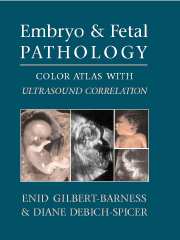Book contents
- Frontmatter
- Contents
- Foreword by John M. Opitz
- Preface
- Acknowledgments
- 1 The Human Embryo and Embryonic Growth Disorganization
- 2 Late Fetal Death, Stillbirth, and Neonatal Death
- 3 Fetal Autopsy
- 4 Ultrasound of Embryo and Fetus: General Principles
- 5 Abnormalities of Placenta
- 6 Chromosomal Abnormalities in the Embryo and Fetus
- 7 Terminology of Errors of Morphogenesis
- 8 Malformation Syndromes
- 9 Dysplasias
- 10 Disruptions and Amnion Rupture Sequence
- 11 Intrauterine Growth Retardation
- 12 Fetal Hydrops and Cystic Hygroma
- 13 Central Nervous System Defects
- 14 Craniofacial Defects
- 15 Skeletal Abnormalities
- 16 Cardiovascular System Defects
- 17 Respiratory System
- 18 Gastrointestinal Tract and Liver
- 19 Genito-Urinary System
- 20 Congenital Tumors
- 21 Fetal and Neonatal Skin Disorders
- 22 Intrauterine Infection
- 23 Multiple Gestations and Conjoined Twins
- 24 Metabolic Diseases
- Appendices
- Index
18 - Gastrointestinal Tract and Liver
Published online by Cambridge University Press: 23 February 2010
- Frontmatter
- Contents
- Foreword by John M. Opitz
- Preface
- Acknowledgments
- 1 The Human Embryo and Embryonic Growth Disorganization
- 2 Late Fetal Death, Stillbirth, and Neonatal Death
- 3 Fetal Autopsy
- 4 Ultrasound of Embryo and Fetus: General Principles
- 5 Abnormalities of Placenta
- 6 Chromosomal Abnormalities in the Embryo and Fetus
- 7 Terminology of Errors of Morphogenesis
- 8 Malformation Syndromes
- 9 Dysplasias
- 10 Disruptions and Amnion Rupture Sequence
- 11 Intrauterine Growth Retardation
- 12 Fetal Hydrops and Cystic Hygroma
- 13 Central Nervous System Defects
- 14 Craniofacial Defects
- 15 Skeletal Abnormalities
- 16 Cardiovascular System Defects
- 17 Respiratory System
- 18 Gastrointestinal Tract and Liver
- 19 Genito-Urinary System
- 20 Congenital Tumors
- 21 Fetal and Neonatal Skin Disorders
- 22 Intrauterine Infection
- 23 Multiple Gestations and Conjoined Twins
- 24 Metabolic Diseases
- Appendices
- Index
Summary
ESOPHAGEAL ATRESIA (SEE ALSO CHAPTER 17)
Esophageal atresia results in a complete separation of the esophagus into upper and lower segments. This is often accompanied by communication of either segment or both with the trachea resulting in tracheoesophageal fistula (TEF). It is accompanied by polyhydramnios in which the fetus is unable to swallow amniotic fluid.
The incidence is from 1/800 to 1/5,000 live births.
Pathogenesis
At approximately 4 weeks of development, a diverticulum grows caudally from the ventral wall of the foregut to form the trachea and esophagus. Tracheoesophageal folds forma tracheoesophageal septum, which separates the trachea from the esophagus at the 5th week of embryonic development.
If there is failure of normal septum formation, it results in a TEF with two disconnected segments of the esophagus.
Esophageal atresia is usually sporadic, although there have been about 80 reports of familial atresia with TEF. It also may occur in trisomy 18 or 21.
In over 80% of cases, the upper esophageal segment ends blindly and the lower segment communicates with the trachea (TEF). In approximately 10%, there is isolated atresia of the esophagus; in 1-3%, the upper segment joins the trachea; in 5%, both segments join the trachea. In the region of the fistula, the trachea is often narrow, and tracheal cartilage may be hypoplastic or absent. (See Chapter 17.)
The most frequently associated malformations are gastrointestinal defects, with about one-half associated with an imperforate anus. Cardiovascular malformations, such as persistent ductus arteriosus, VSD, ASD, right-sided aortic arch, dextrocardia, and urogenital defects, such as renal agenesis and hydronephrosis may be associated.
- Type
- Chapter
- Information
- Embryo and Fetal PathologyColor Atlas with Ultrasound Correlation, pp. 490 - 512Publisher: Cambridge University PressPrint publication year: 2004

